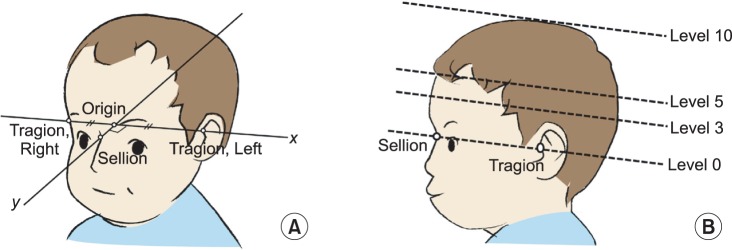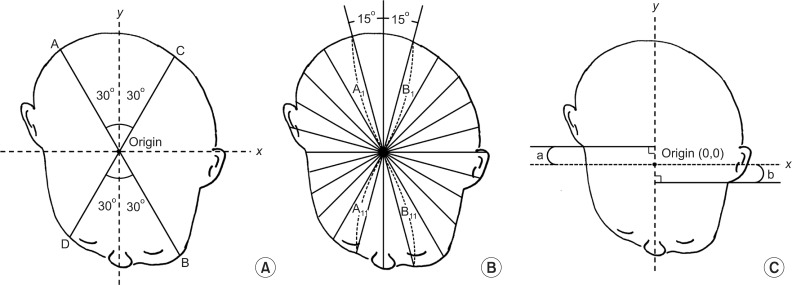Ann Rehabil Med.
2013 Dec;37(6):785-795. 10.5535/arm.2013.37.6.785.
Comparison of Helmet Therapy and Counter Positioning for Deformational Plagiocephaly
- Affiliations
-
- 1The Clinic for Torticollis, Department of Physical Medicine and Rehabilitation, Ajou University School of Medicine, Suwon, Korea. syyim@ajou.ac.kr
- 2Department of Pediatrics, Ajou University School of Medicine, Suwon, Korea.
- 3Department of Obstetrics and Gynecology, Ajou University School of Medicine, Suwon, Korea.
- KMID: 2266557
- DOI: http://doi.org/10.5535/arm.2013.37.6.785
Abstract
OBJECTIVE
To compare effectiveness on correcting cranial and ear asymmetry between helmet therapy and counter positioning for deformational plagiocephaly (DP).
METHODS
Retrospective data of children diagnosed with DP who visited our clinic from November 2010 to October 2012 were reviewed. Subjects < or =10 months of age who showed > or =10 mm of diagonal difference were included for analysis. For DP treatment, information on both helmet therapy and counter positioning was given and either of the two was chosen by each family. Head circumference, cranial asymmetry measurements including diagonal difference, cranial vault asymmetry index, radial symmetry index, and ear shift were obtained by 3-dimensional head-surface laser scan at the time of initiation and termination of therapy.
RESULTS
Twenty-seven subjects were included: 21 had helmet therapy and 6 underwent counter positioning. There was no significant difference of baseline characteristics, head circumferences and cranial asymmetry measurements at the initiation of therapy. The mean duration of therapy was 4.30+/-1.27 months in the helmet therapy group and 4.08+/-0.95 months in the counter positioning group (p=0.770). While cranial asymmetry measurements improved in both groups, significantly more improvement was observed with helmet therapy. There was no significant difference of the head circumference growth between the two groups at the end of therapy.
CONCLUSION
Helmet therapy resulted in more favorable outcomes in correcting cranial and ear asymmetry than counter positioning on moderate to severe DP without compromising head growth.
Keyword
MeSH Terms
Figure
Cited by 1 articles
-
Factors That Affect the Rehabilitation Duration in Patients With Congenital Muscular Torticollis
Ah Young Jung, Eun Young Kang, Sung Hoon Lee, Doo Hyeon Nam, Ji Hwan Cheon, Hyo Jung Kim
Ann Rehabil Med. 2015;39(1):18-24. doi: 10.5535/arm.2015.39.1.18.
Reference
-
1. Kalra R, Walker ML. Posterior plagiocephaly. Childs Nerv Syst. 2012; 28:1389–1393. PMID: 22872253.
Article2. Mortenson P, Steinbok P, Smith D. Deformational plagiocephaly and orthotic treatment: indications and limitations. Childs Nerv Syst. 2012; 28:1407–1412. PMID: 22872256.
Article3. Looman WS, Flannery AB. Evidence-based care of the child with deformational plagiocephaly. Part I: assessment and diagnosis. J Pediatr Health Care. 2012; 26:242–250. PMID: 22726709.
Article4. American Academy of Pediatrics Task Force on Infant Positioning and SIDS. Positioning and SIDS. Pediatrics. 1992; 89(6 Pt 1):1120–1126. PMID: 1503575.5. Dunn PM. Congenital sternomastoid torticollis: an intrauterine postural deformity. Arch Dis Child. 1974; 49:824–825. PMID: 21032516.
Article6. Roby BB, Finkelstein M, Tibesar RJ, Sidman JD. Prevalence of positional plagiocephaly in teens born after the "Back to Sleep" campaign. Otolaryngol Head Neck Surg. 2012; 146:823–828. PMID: 22241785.
Article7. Boere-Boonekamp MM, van der Linden-Kuiper LT. Positional preference: prevalence in infants and follow-up after two years. Pediatrics. 2001; 107:339–343. PMID: 11158467.
Article8. Hutchison BL, Hutchison LA, Thompson JM, Mitchell EA. Plagiocephaly and brachycephaly in the first two years of life: a prospective cohort study. Pediatrics. 2004; 114:970–980. PMID: 15466093.
Article9. Saeed NR, Wall SA, Dhariwal DK. Management of positional plagiocephaly. Arch Dis Child. 2008; 93:82–84. PMID: 18156480.
Article10. Thompson JT, David LR, Wood B, Argenta A, Simpson J, Argenta LC. Outcome analysis of helmet therapy for positional plagiocephaly using a three-dimensional surface scanning laser. J Craniofac Surg. 2009; 20:362–365. PMID: 19258908.
Article11. Bialocerkowski AE, Vladusic SL, Wei Ng C. Prevalence, risk factors, and natural history of positional plagiocephaly: a systematic review. Dev Med Child Neurol. 2008; 50:577–586. PMID: 18754894.
Article12. Persing J, James H, Swanson J, Kattwinkel J. American Academy of Pediatrics Committee on Practice and Ambulatory Medicine, Section on Plastic Surgery and Section on Neurological Surgery. Prevention and management of positional skull deformities in infants. Pediatrics. 2003; 112(1 Pt 1):199–202. PMID: 12837890.
Article13. Clarren SK, Smith DW, Hanson JW. Helmet treatment for plagiocephaly and congenital muscular torticollis. J Pediatr. 1979; 94:43–46. PMID: 758420.
Article14. Schaaf H, Malik CY, Streckbein P, Pons-Kuehnemann J, Howaldt HP, Wilbrand JF. Three-dimensional photographic analysis of outcome after helmet treatment of a nonsynostotic cranial deformity. J Craniofac Surg. 2010; 21:1677–1682. PMID: 21119399.
Article15. Moss SD. Nonsurgical, nonorthotic treatment of occipital plagiocephaly: what is the natural history of the misshapen neonatal head? J Neurosurg. 1997; 87:667–670. PMID: 9347972.
Article16. O'Broin ES, Allcutt D, Earley MJ. Posterior plagiocephaly: proactive conservative management. Br J Plast Surg. 1999; 52:18–23. PMID: 10343585.17. Pollack IF, Losken HW, Fasick P. Diagnosis and management of posterior plagiocephaly. Pediatrics. 1997; 99:180–185. PMID: 9024443.
Article18. Loveday BP, de Chalain TB. Active counterpositioning or orthotic device to treat positional plagiocephaly? J Craniofac Surg. 2001; 12:308–313. PMID: 11482615.
Article19. Bialocerkowski AE, Vladusic SL, Howell SM. Conservative interventions for positional plagiocephaly: a systematic review. Dev Med Child Neurol. 2005; 47:563–570. PMID: 16108460.
Article20. Katzel EB, Koltz PF, Sbitany H, Emerson C, Girotto JA. Real versus perceived improvements of helmet molding therapy for the treatment of plagiocephaly. Plast Reconstr Surg. 2010; 126:19e–21e.
Article21. Lipira AB, Gordon S, Darvann TA, Hermann NV, Van Pelt AE, Naidoo SD, et al. Helmet versus active repositioning for plagiocephaly: a three-dimensional analysis. Pediatrics. 2010; 126:e936–e945. PMID: 20837585.
Article22. Graham JM Jr, Gomez M, Halberg A, Earl DL, Kreutzman JT, Cui J, et al. Management of deformational plagiocephaly: repositioning versus orthotic therapy. J Pediatr. 2005; 146:258–262. PMID: 15689920.23. Lee A, Van Pelt AE, Kane AA, Pilgram TK, Govier DP, Woo AS, et al. Comparison of perceptions and treatment practices between neurosurgeons and plastic surgeons for infants with deformational plagiocephaly. J Neurosurg Pediatr. 2010; 5:368–374. PMID: 20367342.
Article24. Kluba S, Schreiber R, Kraut W, Meisner C, Reinert S, Krimmel M. Does helmet therapy influence the ear shift in positional plagiocephaly? J Craniofac Surg. 2012; 23:1301–1305. PMID: 22976627.
Article25. Yoo HS, Rah DK, Kim YO. Outcome analysis of cranial molding therapy in nonsynostotic plagiocephaly. Arch Plast Surg. 2012; 39:338–344. PMID: 22872837.
Article26. Meyer-Marcotty P, Bohm H, Linz C, Kunz F, Keil N, Stellzig-Eisenhauer A, et al. Head orthesis therapy in infants with unilateral positional plagiocephaly: an interdisciplinary approach to broadening the range of orthodontic treatment. J Orofac Orthop. 2012; 73:151–165. PMID: 22388713.
Article27. Plank LH, Giavedoni B, Lombardo JR, Geil MD, Reisner A. Comparison of infant head shape changes in deformational plagiocephaly following treatment with a cranial remolding orthosis using a noninvasive laser shape digitizer. J Craniofac Surg. 2006; 17:1084–1091. PMID: 17119410.
Article28. Faul F, Erdfelder E, Lang AG, Buchner A. G*Power 3: a flexible statistical power analysis program for the social, behavioral, and biomedical sciences. Behav Res Methods. 2007; 39:175–191. PMID: 17695343.
Article29. Faul F, Erdfelder E, Buchner A, Lang AG. Statistical power analyses using G*Power 3.1: tests for correlation and regression analyses. Behav Res Methods. 2009; 41:1149–1160. PMID: 19897823.
Article30. Hutchison BL, Hutchison LA, Thompson JM, Mitchell EA. Quantification of plagiocephaly and brachycephaly in infants using a digital photographic technique. Cleft Palate Craniofac J. 2005; 42:539–547. PMID: 16149837.
Article31. Xia JJ, Kennedy KA, Teichgraeber JF, Wu KQ, Baumgartner JB, Gateno J. Nonsurgical treatment of deformational plagiocephaly: a systematic review. Arch Pediatr Adolesc Med. 2008; 162:719–727. PMID: 18678803.32. Clarren SK. Plagiocephaly and torticollis: etiology, natural history, and helmet treatment. J Pediatr. 1981; 98:92–95. PMID: 7452415.
Article33. Argenta L, David L, Thompson J. Clinical classification of positional plagiocephaly. J Craniofac Surg. 2004; 15:368–372. PMID: 15111792.
Article
- Full Text Links
- Actions
-
Cited
- CITED
-
- Close
- Share
- Similar articles
-
- Diagnosis and Treatment of Deformational Plagiocephaly
- A Simple Evaluation Method Using a "Sun-Wukong's Headband" Wire for Positional Plagiocephaly Correction after Cranial Remodeling Helmet Therapy
- Diagnosis and treatment of positional plagiocephaly
- Outcome Analysis of Cranial Molding Therapy in Nonsynostotic Plagiocephaly
- Effectiveness of Helmet therapy for infants with moderate to severe positional plagiocephaly




